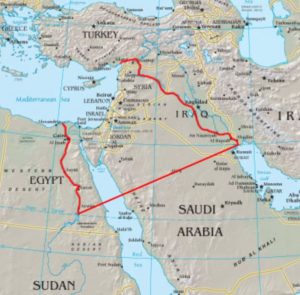This week’s parasha, Chayei Sarah, begins with the passing of Sarah, and Abraham’s securing of a burial plot for her. He specifically chooses Me’erat HaMakhpelah, a cave in Hebron, and pays a handsome price for it. Why was this place special and how did Abraham know that this was the right place to lay Sarah? The Zohar (I, 127a) comments that Abraham saw a vision of the Garden of Eden at that spot and, when he entered the cave, found Adam and Eve buried there. The Zohar suggests that this area was once the Garden of Eden!
It would definitely make sense for the Garden of Eden to be in the Holy Land. When Adam and Eve were banished from the Garden, the Torah says they lived east of it (Genesis 3:24). Cain, too, when banished, fled east—and there built the first city (Genesis 4:16-17). Since this city was in Mesopotamia, which is directly east of Israel, the implication is that Eden was in the Holy Land. Israel is called tabur ha’aretz, the “navel of the Earth” (Ezekiel 38:12), and is described in more mystical texts as the very centre of the entire universe, the point of origin of Creation.
Having said that, the Torah also says that Eden was locked up after Adam and Eve’s error, and God placed angels to guard its entrance (Genesis 3:24). What happened between that time and the time that Abraham found it? The only explanation that comes to mind is that Eden was destroyed during the Great Flood. Yet, the Midrash (Beresheet Rabbah 33:6) presents one opinion that the Land of Israel was not affect by the Great Flood! The proof is from Ezekiel 22:24, which says that Israel “was not cleansed, nor rained upon in the day of fury.”
This solves another problem: where did the dove that Noah sent get an olive branch? The Midrash says it got the branch from Israel, which miraculously did not experience the Flood. Some hold that Israel did experience the Flood, just that it did not rain directly upon the Holy Land; water flowed in from surrounding lands. Finally, the Midrash presents an opinion that the dove got the olive branch directly from the Garden of Eden! This suggests Eden was not destroyed by the Flood.
And then there are altogether different opinions regarding the location of Eden.
Rivers of Eden
The Sages teach that the first person to offer a sacrifice to God was Adam (Avodah Zarah 8a). There is even an opinion that Adam sacrificed a special kind of animal no longer extant: a beast with a large, singular horn. (Some take this to refer to a unicorn!) Where did he offer this sacrifice? In his Sefer Sha’arei Tzedek, the great kabbalist Rabbi Yosef HaKatan (“Chiquitilla”, often mistransliterated as “Gikatilla”, c. 1248-1305) wrote:
[Mount Zion] is the gate through which one can enter to see the face of the King, Hashem. Therefore, the Holy Temple was built upon Mount Zion. Know and believe that this was also the place where Adam brought an offering… and this is the place where Noah built an altar to God, and this is the place called “Mount Moriah” where Isaac was bound…
If Adam brought a sacrifice upon Mt. Moriah, it implies that this area, too, was part of the Garden of Eden. (Alternatively, if Adam brought this sacrifice following his banishment from Eden, then Mt. Moriah would be slightly east of Eden.) The most likely explanation is that Eden must have been a large territory—not just a small garden—and probably extended throughout the entire Land of Israel. This is supported by Genesis 13:10, which says that Sodom and Gomorrah—along with the entire Jordan Valley—were originally lush and fertile lands, “like the garden of God”. The notion that all of Israel was Eden might be alluded to in the Torah when it says:
And a river went out of Eden to water the garden; and from there it parted, and became four heads. The name of the first is Pishon, which encompasses the whole land of Havilah, where there is gold; and the gold of that land is good; there is bdellium and the onyx stone. And the name of the second river is Gihon, which encompasses the whole land of Cush. And the name of the third river is Hidekel, which goes toward the east of Ashur. And the fourth river is the Euphrates. (Genesis 2:10-14)
One way to read this passage is that Eden’s boundaries were delineated by four rivers. Hidekel is generally translated as the Tigris River, which usually goes together with its next-door neighbour, the Euphrates. Rashi comments that “Pishon” refers to the Nile. One might think that “Gihon” should refer to the Nile, since it originates in Cushite lands. Pishon might be referring to the Litani River that runs through modern Lebanon, whose name comes from the Biblical Lotan. Lebanon is indeed a land of riches, and once sent many resources and precious materials for the construction of Solomon’s Temple (see II Chronicles 2).
If defined this way, the four rivers would delineate the widest borders of Israel, which may extend as far west as the Nile and as far east as the Tigris and Euphrates, as God promised Abraham: “In that day, God made a covenant with Abram, saying: ‘To your seed I have given this land, from the river of Egypt unto the great river, the river Euphrates.’” (Genesis 15:18) Sometimes referred to as “Greater Israel”, this is the extent of the territory God promised His people, and the area to which Israel might expand in the Messianic Era. (For more on this, see ‘What Are the True Borders of Israel?‘)
Archaeology might offer a couple of more intriguing possibilities for the location of Eden…


